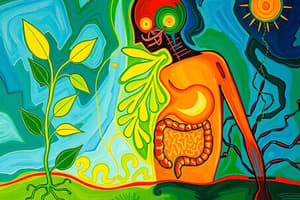Podcast
Questions and Answers
What is the main product of the Calvin Cycle?
What is the main product of the Calvin Cycle?
- Oxygen
- Carbon dioxide
- Glucose (correct)
- ATP
The Calvin Cycle occurs during the day time.
The Calvin Cycle occurs during the day time.
False (B)
What enzyme is responsible for joining carbon dioxide to RuBP in the Calvin Cycle?
What enzyme is responsible for joining carbon dioxide to RuBP in the Calvin Cycle?
Rubisco
Photorespiration occurs when there is insufficient ____.
Photorespiration occurs when there is insufficient ____.
Match the following plant types with their adaptations to limit photorespiration:
Match the following plant types with their adaptations to limit photorespiration:
What are the reactants of the light-dependent reactions of photosynthesis?
What are the reactants of the light-dependent reactions of photosynthesis?
ATP and NADPH are produced in the light-independent reactions of photosynthesis.
ATP and NADPH are produced in the light-independent reactions of photosynthesis.
What are G3P molecules related to in the Calvin Cycle?
What are G3P molecules related to in the Calvin Cycle?
Where does the light-dependent stage of photosynthesis occur?
Where does the light-dependent stage of photosynthesis occur?
ATP is used in the Calvin Cycle to regenerate RuBP.
ATP is used in the Calvin Cycle to regenerate RuBP.
In CAM plants, when do stomates close to limit water loss?
In CAM plants, when do stomates close to limit water loss?
Water is split into hydrogen ions (H+) and ________ during the light-dependent stage.
Water is split into hydrogen ions (H+) and ________ during the light-dependent stage.
Match the following components of photosynthesis with their functions:
Match the following components of photosynthesis with their functions:
What is the primary purpose of the light-dependent reactions?
What is the primary purpose of the light-dependent reactions?
The Calvin Cycle occurs in the thylakoid membranes of the chloroplast.
The Calvin Cycle occurs in the thylakoid membranes of the chloroplast.
What ion channels facilitate the movement of hydrogen ions (H+) during photosynthesis?
What ion channels facilitate the movement of hydrogen ions (H+) during photosynthesis?
Flashcards
Light-Dependent Reactions
Light-Dependent Reactions
The stage of photosynthesis that requires light energy to convert water and light into ATP and NADPH.
ATP
ATP
A molecule that stores and transfers energy in cells, produced during the light-dependent reactions.
NADPH
NADPH
A molecule that carries energized electrons, produced during the light-dependent reactions.
Water Splitting
Water Splitting
Signup and view all the flashcards
Calvin Cycle
Calvin Cycle
Signup and view all the flashcards
Carbon Dioxide
Carbon Dioxide
Signup and view all the flashcards
Glucose
Glucose
Signup and view all the flashcards
Stroma
Stroma
Signup and view all the flashcards
Carbon Fixation
Carbon Fixation
Signup and view all the flashcards
Rubisco
Rubisco
Signup and view all the flashcards
Photorespiration
Photorespiration
Signup and view all the flashcards
CAM plants
CAM plants
Signup and view all the flashcards
Light Intensity
Light Intensity
Signup and view all the flashcards
CO2 Concentration
CO2 Concentration
Signup and view all the flashcards
Temperature
Temperature
Signup and view all the flashcards
Study Notes
Photosynthesis Overview
- Photosynthesis is the process by which plants convert carbon dioxide and water into sugars, using sunlight as energy.
- The overall equation for photosynthesis is: CO2 + H2O + Sunlight → C6H12O6 + O2 (Carbon dioxide + Water + Sunlight → Glucose + Oxygen)
- The process occurs in chloroplasts, specifically within the thylakoid membranes and stroma.
Stages of Photosynthesis
- Photosynthesis is divided into two main stages:
- Light-dependent reactions
- Light-independent reactions (Calvin cycle)
Light-Dependent Reactions
- Location: Thylakoid membranes within chloroplasts.
- Reactants: Sunlight and water
- Process:
- Light energy is absorbed by chlorophyll.
- Water is split into hydrogen ions (H+) and oxygen.
- High-energy electrons are passed down an electron transport chain.
- This process creates ATP and NADPH, which are energy carriers.
- Oxygen is released as a byproduct.
- Products: ATP, NADPH, and oxygen.
Light-Independent Reactions (Calvin Cycle)
- Location: Stroma of chloroplasts.
- Reactants: ATP, NADPH, and carbon dioxide.
- Process:
- Carbon dioxide is "fixed" into an organic molecule (glucose).
- Energy from ATP and NADPH is used to convert 3-carbon molecules into a 6-carbon sugar, glucose.
- Products: Glucose (sugar).
Factors Affecting Photosynthesis
- CO2 Concentration: At low CO2 levels, the rate of photosynthesis is limited. More CO2 leads to a higher photosynthesis rate until a point, where it plateaus as CO2 is no longer the limiting factor.
- Light Intensity: Increasing light intensity increases the rate of photosynthesis up to a certain point, after which it plateaus.
- Temperature: Photosynthesis has an optimum temperature range. Temperatures above or below this range will negatively affect the rate of photosynthesis.
Limiting Factors
-
In a metabolic pathway, if one factor is low, the reaction is slowed. The factor closest to its minimum is the limiting factor.
-
Light intensity: Low light intensity slows ATP and NADPH production, rarely the limiting factor.
-
CO2 concentration: Low atmospheric CO2 is often the limiting factor.
-
Temperature: Low temperature slows enzyme-catalyzed reactions. High temperature can denature Rubisco, preventing carbon fixation.
Photosynthesis Adaptations in Plants
- CAM plants: Plants in hot, dry environments have adaptations to reduce photorespiration, closing their stomata during the day to prevent water loss. They take in CO2 at night to store for use during the day, thus reducing competition with oxygen.
Summary of crucial information
- Photosynthesis is fundamental to life on Earth.
- It involves converting light energy into chemical energy in the form of sugars.
- Two main stages (light-dependent & light-independent) work together.
- Various environmental factors influence the rate of photosynthesis.
Studying That Suits You
Use AI to generate personalized quizzes and flashcards to suit your learning preferences.



